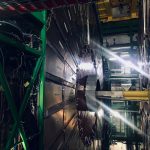The World-Wide-Web is currently celebrating its 30th anniversary; you can get the T-shirt in the CERN visitor centre! Five years on, in May 1994, the first Web conference took place (WWW94) at CERN and now celebrating its own 25th anniversary. That 1994 conference also had various break-out sessions, one of which summarised the state of chemistry on the web at the time. You can see my general but entirely personal impressions written after the workshop (DOI: 10.14469/hpc/5850), with a chemistry specific version at DOI: 10.14469/hpc/5851. A real trip down memory lane and an indication of how much has happened in 25 years!
I was lucky enough to be able to visit CERN a few days ago, primarily to view the CMS (Compact Muon Solenoid) detector and I also took the opportunity to remember WWW94. Here are a few photos of the visit. Note the chemistry seen in the final photo, taken in the control room (hint: look on the shelf at the back).
- It is safe to enter the ring
- 91m underground
- View of the CMS
- Lead tungstate crystal array (not from CMS)
- View of the CMS
- Fibre cables carrying the data
- The final 27 km ring, Control room.
- Some of the visitors
You can find a full report of the visit at https://www.imperial.ac.uk/news/191569/imperial-celebrates-towering-intellectual-achievement-cern/ with more photos. It is noteworthy that as well as celebrating the achievements of the LHC, we also find that “CERN’s work often leads to paradigm-shifting technologies, … The most famous example is the World Wide Web, which was invented by British scientist Tim Berners-Lee while working at CERN in 1989.” Hence the link between WWW94 and the CMS.
I end with some chemistry. The design of the CMS detector (one of two that detected the Higgs Boson) took 27 years to complete! It started in the mid 1980s at a point when some of the science required for the detector was still unknown! It was a stupendous act of faith that during the time it took to design the detector, science would provide a solution. One such solution took the form of Lead tungstate (PbWO4), which scintillates when struck by high energy particles. Some 75,848 single crystals of lead tungstate were used in the detector, each being 23 cm long and weighing in total 100 tonnes! The technology to purify and then crystallise this material to optical transparency was developed in Russia and China.
The CMS is now undergoing experiments to find the missing mass in the universe, the so-called dark matter. Maybe another visit in 25 years time is called for to hear where that missing mass is!








I found out yesterday that CERN continues to be at the forefront of connecting the world. With all that data being produced by the LHC, getting it to the researchers is important (and one of the reasons for the invention of the World Wide Web in the first place). Thus the bandwidth from CERN to its researchers at Imperial College has recently been increased to 100 Gbps, in fact the first UK university with such bandwidth.
Further, in the next couple of years or so, CERN will start operating 1 Tbps links (ten times faster). If you think that 5G mobile phone connectivity is fast, just wait for Tbps to your phone (overkill?).